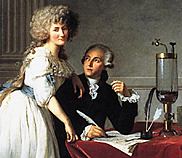

For 101 days beginning October 1768 Antoine Lavoisier (born Paris, 1743, died 1794) distilled and condensed water in a sealled container. Its weight remained unchanged. Water is inconvertable!
In 1771 at age 28, Antoine Lavoisier married 13 years old Marie-Anne Pierrette. She learned English to keep Antoine abreast of chemical progress occuring in England. She helped with the experiments, recorded observations and results, and drew sketches for his notebook and publications. They lived in an age when all accomplishments were attributed to men. But perhaps the new chemistry of Lavoisier
should be considered the product of their teamwork.

In 1772 he found, contrary to the Phlogiston theory, that burning both phosphorus and sulfur increases their weights, producing acid forming gases.
When Priestly visited Paris in October 1774, he met Lavoisier and shared his discovery of dephlogisticated air. Lavoisier amplified Priestly's experiment to prove that that air absorbed by heating mercury gently to form the red calx is exactly the same volume as the dephlogisticated air
liberated by heating more strongly.
Convinced that evidence was finally at hand showing that air and water are not single elements, Lavoisier believed that Boyle's century old proposed definition of element could explain all the distinctly different airs
as well as the weight contradictions in the phlogiston theory. Elements
are the substances we have not discovered means for separating. They are all the substances into which we are capable to reduce (in weight) bodies by decomposition. Lavoisier conducted a great systematic series of experiments, reporting the results periodically in memoirs
to the Academie Royale des Sciences.
All the while he was heavily engaged in official duties as fermier generale (financiers that leased the right for French tax collections on commerce). He also was active promoting improvements for French political, social, and economic conditions.
Lavoisier published in 1789 theTraite elementaire de Chimie...describing a revolutionary new system of chemistry. Lavoisier's book describes the new chemistry: besides the new concept of element, it contains
facts,
facts,and
The Four Element Theory was abandoned: Each distinctive Air
becomes a different gas, many of them elements. Water
becomes a compound of the elements Hydrogene and Oxygene. Earth
is a variety of substances, mostly compounds. Fire
becomes two elements: Calorique (heat) and Lumiere (light).
The metal compounds studied by the alchemists become seventeen different elements. Mercury is merely one of the metallic elements. Mixtures of metals become alloys.
Combustion is the process of combination with Oxygene. All acids are compounds containing Oxygene and a distinctive element. Soufre (Sulfur) is one of six nonmetallic acidifiable elements. Salts are the combination of acids and either metals or earthly bases. Lavoisier expect the Alkalies to be found to be compound.
| Simple Subftances | Current Names: | non-metallic Oxydable & Acidifiable |
Current Names: Non-metals |
Metallic Bodies Oxydable & Acidifiable |
Current Names: Metals |
Simple Salifiable Earthy Subftances | Current Names: Natural salts |
| Lumiere Calorique Oxygene Azote Hydrogene |
Light* Heat* Oxygen Nitrogen Hydrogen |
Soufre Phofphore Carbone Radical muriatique Radical fluorique Radical boracique |
Sulfur Phosphorus Carbon element in chlorine+ element in fluorine+ element in borate |
Antimoine Argent Arienic Bifmuth Cobalt Cuivre Etain Fer Manganefe Mercure Molybdene Nickel Or Platine Plomb Tungftene Zinc |
Antimony Silver Arsenic Bismuth Cobalt Copper Tin Iron Manganese Mercury Molybdenium Nickel Gold Platinium Lead Tungstun Zinc |
Chaux Magnefie Baryte Alumine Silice |
Calcium oxide Magnesium oxide Barium oxide Aluminum oxide Silicon dioxide |
| * since rejected as elements | + never isolated | (↑ decomposed later using electricity; now compounds, not elements) |
During the Reign of Terror in 1994, Antoine Lavoisier was arrested with 27 others by the French Revolutionary Tribune for abusing the office of fermier general by adulterating tobacco and water. They were guillotined the same day. Later Marie-Anne was briefly married to Count Rumford.


| introduction | Greeks | alchemy | ↑ | Dalton | Berzelius | molecules | spectra | electron | radiation | Bohr | isotopes | synthesis |
| to site menu | Discovery and Naming of Chemical Elements |
chemistry | physics | |||||||||
| page created 23 March 2002 latest revision 26 April 2010 |
by D Trapp | |||||||||||